Zoo is a place where people keep and display animals. Visiting zoos is a popular recreational and educational activity throughout the world. Almost every large city has at least one zoo, and many smaller communities also have one. Many zoos have beautiful gardens and treelined paths leading from one animal display to another. The word zoo is short for zoological garden.
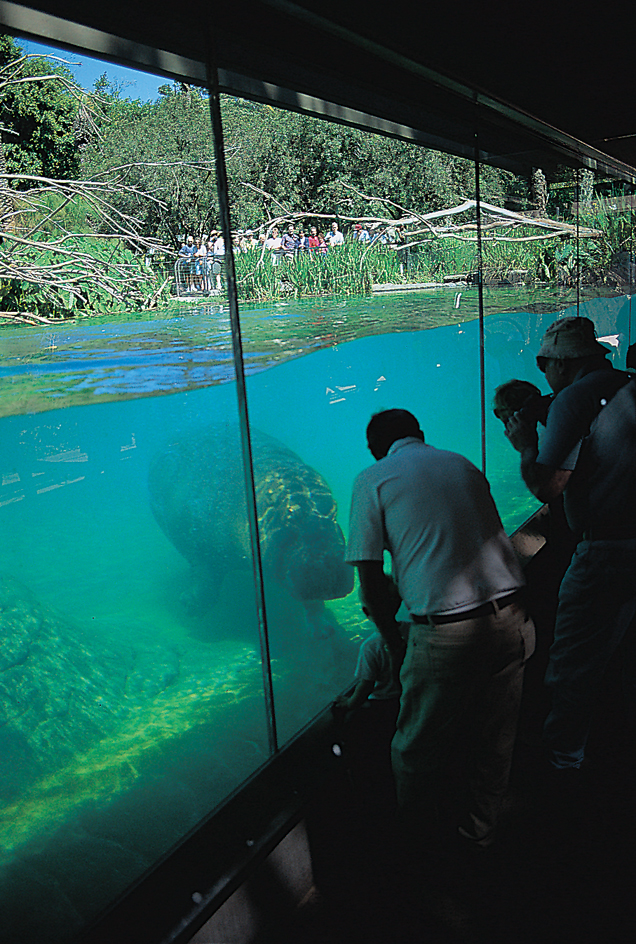
Zoos vary in the type of animals they keep. Many large zoos keep mammals, birds, reptiles, and fish from all over the world. Some even have collections of interesting insects. Smaller zoos may have animals from just one part of the world, or just one type of animal. Zoos that have only fish and aquatic mammals, which live in water, are called aquariums. Some zoos display only animals from the region where the zoo is located.
Zoos range in size from hundreds of acres or hectares to only a few. But size alone does not determine the quality or importance of a zoo. The best zoos are those that have healthy, well-tended animals and displays that help visitors learn about each animal’s natural behavior and its role in the environment.
Modern zoos have become refuges for some species (types) of animals that are in danger of extinction (dying out) in the wild. Many human activities threaten the survival of wild species, especially the destruction of habitats (natural environments). Most animals are specially suited to live in a certain environment and cannot survive when their habitat is destroyed. Zoos are becoming increasingly active in the struggle to save the world’s vanishing wildlife.
The importance of zoos
Zoos are important centers for (1) recreation and education, (2) wildlife conservation, and (3) scientific studies.
Recreation and education.
People of all ages enjoy viewing animals they would probably never see otherwise. In the United States and Canada, zoos attract millions of visitors every year. Zoos also help people understand how animals live. In addition, zoos teach people about the problems facing wildlife and about conservation.
In many zoos, trained workers give visitors brief talks and provide guided tours. Many zoos have education departments that conduct lectures, classes, and group programs for children and adults. Some zoos offer summer day camps and junior zookeeper programs that give youngsters opportunities to help care for the animals. In addition, zoos publish magazines, pamphlets, and other materials that describe their activities. Some zoos even produce television programs.
Wildlife conservation
has become one of the most important jobs of zoos. Zoos breed many endangered species to increase their numbers. Such captive breeding in zoos has helped save several species from extinction, including the European bison; the nene, also known as the Hawaiian goose; and the Arabian oryx, a type of antelope.
Zoos throughout the world trade and lend animals to one another to avoid inbreeding (breeding animals that are closely related to each other). Inbreeding can produce birth defects and can eventually weaken an entire population. A number of zoo associations share breeding information through the International Species Information System (ISIS), a computerized inventory of hundreds of thousands of animals cared for by zoos throughout the world. ISIS also maintains records on the ancestors of the animals to more accurately track the genetic background of the living animals.
The Association of Zoos and Aquariums sponsors the Species Survival Plan (SSP), a long-term plan to save some of the most seriously endangered species. Many major zoos in the United States and other countries participate in the SSP. There are dozens of SSP programs, each focusing on a different species or group of species. Participating zoos keep careful records of each animal’s family lines and physical characteristics. Zoos use this information to determine which males and females to breed together. The goal is to develop healthy populations of animals that can someday be returned to the wild.
Zoos also participate in conservation projects outside their walls. For example, many zoos sponsor efforts to preserve the natural habitats of threatened species, such as the Asian bamboo forests of the giant panda and the South American tropical rain forests of the lion tamarin, a species of small monkey.
Scientific studies.
Zoos provide scientists with living laboratories in which to study animals. By treating diseased animals and by studying animals that have died, zoo veterinarians and other scientists have developed and improved medical equipment, drugs, and surgical techniques for animals.
Scientists called zoologists study animals in zoos, as well as in the wild, to learn about animal behavior, such as hunting, eating, breeding, and caring for the young. Such research helps zoos know how to better care for their animals and how to make their exhibits as natural as possible. This knowledge is especially important for breeding because many animals will only reproduce if they are healthy and living in natural surroundings.
Scientific progress in breeding techniques has greatly reduced the need to move animals from zoo to zoo for mating. Researchers can freeze the sperm and embryos of various species. The frozen material can be shipped to another zoo for use in artificial insemination, embryo transfer, and other breeding techniques (see Breeding (Animal breeding)).
Displaying animals
In the past, zoos kept their animals in rows of mostly bare cages made of concrete and steel bars. Often, the cages were arranged in no particular order.
Today, animal displays are far different. Zoos have replaced most old-fashioned cages with natural-looking enclosures that give animals greater liberty to lead normal lives. Both the layout of the zoo and the design of the exhibits teach visitors about animals.
Layout of a zoo.
Many zoos group their animals mostly by type. For example, lions, tigers, and other large cats may be kept in the same building or in nearby outdoor exhibits. Animals from similar climates, such as warm tropical areas or chilly polar regions, are often housed together. Zoos also group animals by the continent where they naturally live, such as Africa or Asia. Another grouping method is by the animals’ natural habitat, such as the East African savanna (grassland with scattered trees) or the Australian desert. In habitat groupings, many animals appear to be living together. However, animals that would attack each other are kept apart by empty moats (deep, wide pits) or by hidden fences.
Many zoos contain a children’s zoo, where boys and girls can pet and even feed tame animals. Some children’s zoos give city youngsters an opportunity to see farm animals. Many children’s zoos feature baby animals.
Exhibits.
Most modern exhibits, both indoors and outdoors, are naturalistic–that is, they resemble the animal’s natural habitat. Such exhibits contain rock formations, pools, grass, trees, shrubs, and places for the animals to take shelter or hide. Heating coils may be concealed in artificial rocks or trees to attract the animals to locations where they can be seen by visitors.
Many animals become bored if they have nothing to do. To combat boredom, exhibits may provide climbing structures and toys that encourage active behavior. Giant ice cubes keep polar bears occupied. Rhinoceroses and elephants seem to enjoy rolling in shallow pools of mud. In addition, keepers often hide meals in shrubs, trees, and other places so that the animals must search for the food just as they would in the wild. A stimulating environment is especially important to apes, elephants, and other intelligent species. In some zoos, chimpanzees may keep busy for hours probing artificial termite mounds filled with honey, cereal, or other treats.
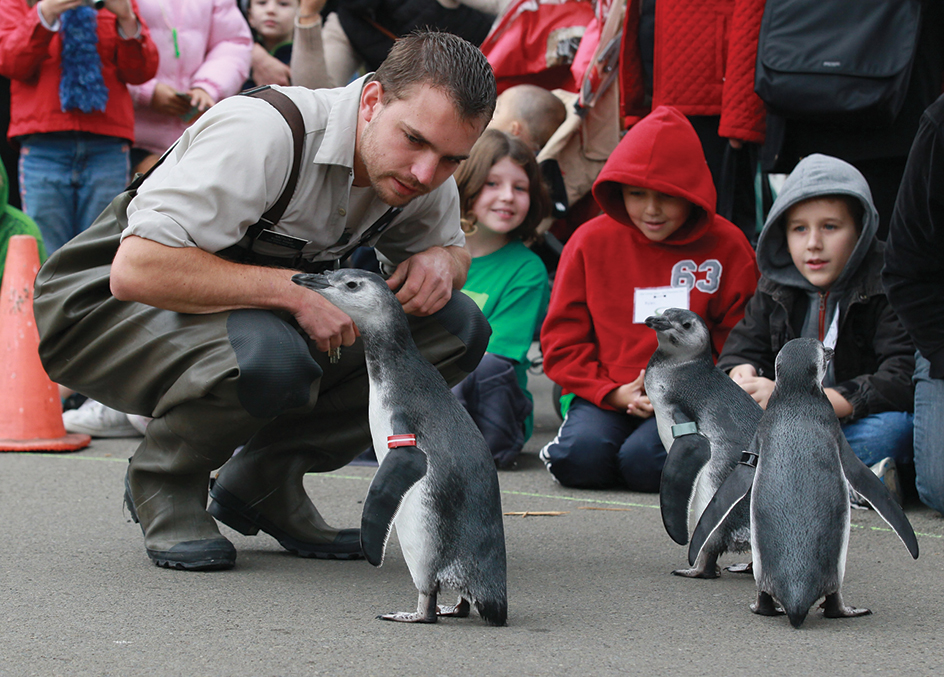
Barriers.
Zoos use a variety of barriers to keep animals in their exhibits. One widely used naturalistic barrier is a moat surrounding the display area. Moats enable zoos to safely keep bears, lions, tigers, and other large animals in spacious outdoor settings.

Zoos also use barriers that are almost invisible, such as glass or a net of thin wire. Through underwater viewing windows, visitors can watch such animals as polar bears and hippopotamuses swimming or observe beavers building a dam. A zoo may cover a huge bird shelter, complete with trees and plants, with a wire net.

Controlled environments.
Indoor exhibits enable zoos to reproduce the environmental conditions that some animals need to stay healthy. For example, penguins from the Antarctic need cold air. Other creatures may require moist air, dry air, or regular rain showers.
One special indoor exhibit is for nocturnal animals, which are active at night. Zoos display such nocturnal animals as owls, bats, and raccoons under a blue light or other dim light, which seems like darkness to the animals. But visitors can clearly see the animals going about their normal nighttime activities. At night, a bright light causes the animals to sleep as if it were day.
With modern technology, a number of zoos have created vast enclosures that imitate scorching deserts, frigid polar regions, and other natural habitats. Such exhibits house a variety of mammals, fish, birds, reptiles, and insects that would naturally live in the environment. A number of zoos, for example, have large indoor exhibits that reproduce steamy tropical rain forests. These exhibits house trees, cliffs, and waterfalls in structures several stories tall. Machines produce a foglike mist. Elevated walkways allow zoogoers to stroll among the treetops and view several types of primates, birds, and other animals that live in the trees.

Cageless zoos.
Drive-through zoos keep their animals in outdoor settings without cages, though predators and prey are kept apart. Visitors view the animals while riding through the zoo in their automobile or aboard a bus or a train.
Wild-animal parks resemble drive-through zoos because the animals are not caged. But these parks are larger than most drive-through zoos and are more interested in breeding animals, especially endangered species, than in exhibiting them. Such parks provide the natural surroundings many animals need to mate successfully and raise offspring. The San Diego Wild Animal Park (now the San Diego Zoo Safari Park), the first such establishment in the United States, opened in 1972. In this enormous zoo, which covers about 2,200 acres (900 hectares), groups of rhinoceroses, giraffes, deer, antelope, zebras, and many other species roam over large areas under the close watch of zoo workers. Visitors ride a special train that travels through the park. The train’s route skirts the areas where animals live, thus disturbing the herds as little as possible.
Caring for zoo animals
Zoo animals receive daily care, special diets, and regular medical attention.
Daily care.
Trained workers called keepers take care of the animals’ daily needs. In large zoos, each keeper usually looks after just one type of animal. The keepers clean the animals’ enclosures. They feed the animals and watch for changes in behavior, eating habits, and overall appearance that may be signs that an animal is sick or injured. Keepers also provide companionship for the animals. Many types of animals, including monkeys and apes, become fond of their keepers and develop special relationships with them.
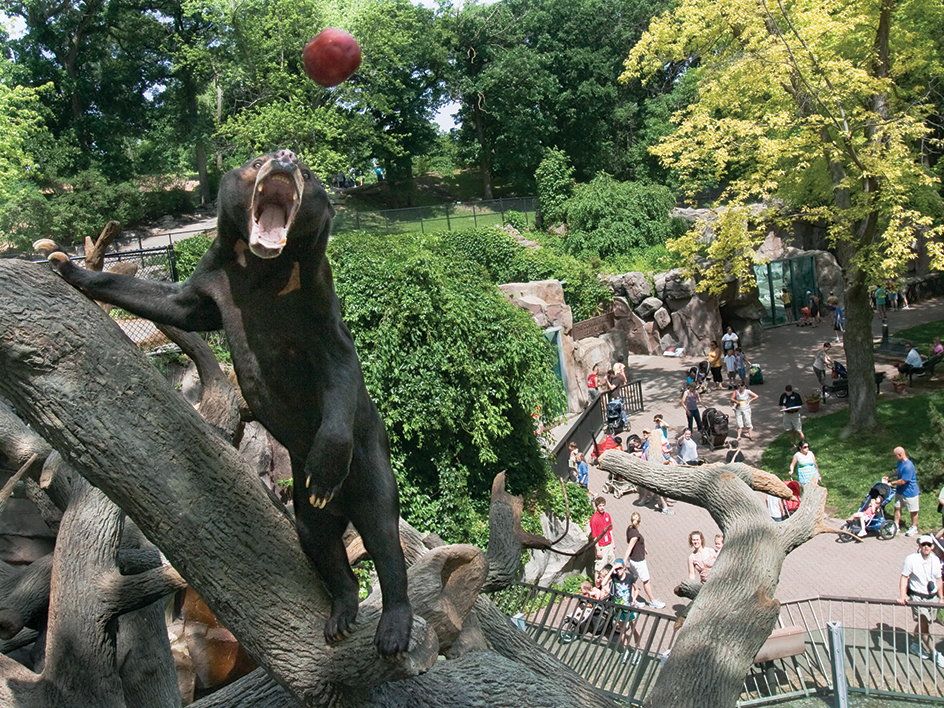
Diet.
An appropriate diet is vital in keeping zoo animals healthy. The kinds and amounts of food different creatures require vary greatly.
Zoo kitchens stock a wide assortment of basic foods, including fruits, vegetables, meat, fish, dairy products, cereals, seeds, grains, and hay. They also have such unusual items as rats, mice, brine shrimp, crickets, worms, and snakes. Many animals enjoy grazing on the leaves of freshly cut branches. In addition, zoos use large quantities of prepared pellets, seed mixes, and other foods made especially for animals. Zoos also use vitamins and mineral supplements to ensure a nutritious diet for each animal.

Some animals require exactly the type of food they would eat in the wild. For example, koalas will eat only certain kinds of eucalyptus leaves. Giant pandas must have bamboo. Zoos ship in these foods from wherever they are grown or grow the foods themselves.
In zoo kitchens, keepers, nutritionists, and other trained workers prepare balanced meals for each animal in whatever form the animal will eat. Some animals eat their food just as it comes. But for many animals, zoo workers must peel, chop, combine, and even cook foods. Some animals, including certain birds and small mammals, eat several meals each day. Other animals, such as some species of snakes, eat only once every few weeks.
A zoo animal’s diet varies under certain circumstances. For example, pregnant females and mothers nursing their young require special food. Animals may also need special diets for gaining or losing weight, for breeding, or for health problems.
Some zoos sell food pellets that visitors may distribute to certain animals. The zoo controls the amount of food provided so the animals are not overfed. Except for such pellets, visitors should not feed zoo animals. Candy, popcorn, and similar foods can make an animal sick. Thoughtless visitors often throw wrappers or other trash to the animals. If an animal swallows this trash, it could become ill and might even die.
Medical care.
Most large zoos employ one or more full-time veterinarians. Smaller zoos often have part-time veterinarians. The doctor visits regularly and treats sick or injured creatures. Many animals receive routine vaccinations to protect them from diseases.
Before examining or treating an animal, the doctor may inject the animal with tranquilizers or drugs that temporarily paralyze the patient. After the drugs take effect, the doctor can examine and treat the animal without danger of injury to either the doctor or the animal.
Many large zoos have their own hospitals with operating rooms, X-ray machines, and laboratories. Some zoos have quarantine areas where newly acquired animals or those with contagious diseases are kept apart from the other animals to prevent the spread of disease.
How zoos operate
Many zoos are owned and operated by local governments. Some zoos are owned by individuals or nonprofit corporations. In the United States, zoos must be licensed by the U.S. Department of Agriculture.
In the United States and Canada, a number of zoos are members of the Association of Zoos and Aquariums. The association requires its members to maintain high standards of animal care and management. All member institutions must pass an inspection every five years.
Funding.
Zoo operations are funded by several sources. Many zoos receive funds from local governments. Most zoos charge admission fees. Other money comes from food and gift shop sales, fund-raising events, donations, “adopt-an-animal” programs, membership fees, and grants from foundations and corporations.
Zoo workers.
A zoo is similar to a small town and needs many types of workers to operate smoothly. A director is the head of the zoo. A curator manages the care of zoo animals and supervises the people who work with the animals. Large zoos may have more than one curator, each overseeing a particular group of animals. Keepers take care of the animals, and veterinarians provide medical care. Zoo scientists study the animals and do research.
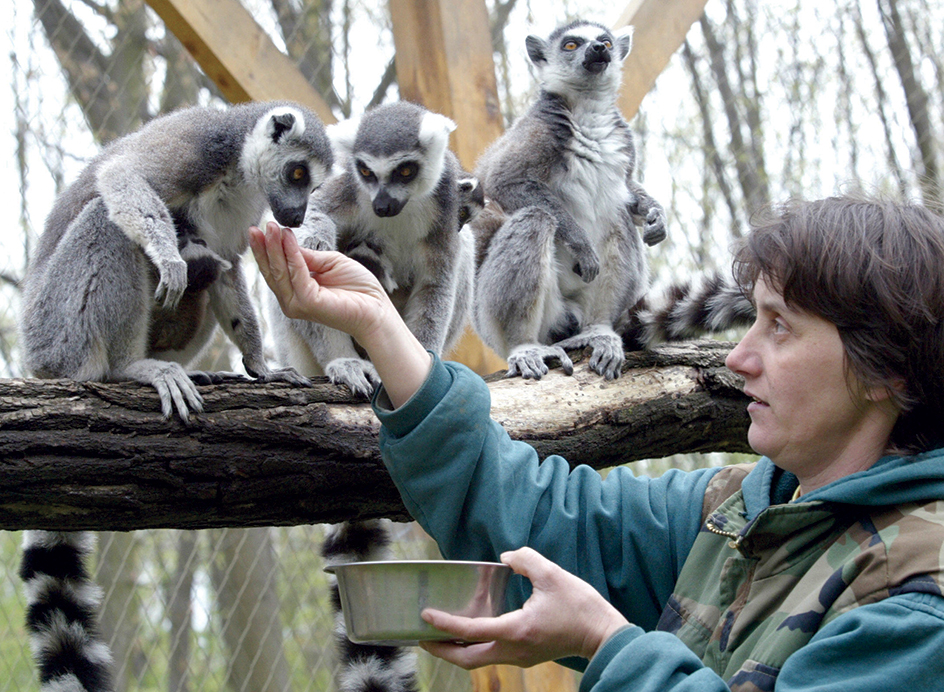
Most zoo jobs that involve working with animals require a college degree. Keepers and curators often study biology or zoology. Zoo scientists usually have training in such fields as animal behavior, genetics, anthropology, nutrition, reproductive science, or veterinary technology. Some veterinary schools offer training in wild-animal medicine. Some zoos provide internships for students at the graduate and undergraduate levels.
Many people who have jobs at zoos do not work directly with the animals. Large numbers of employees are involved in administration, office work, fund-raising, security, and maintaining the grounds and buildings. In addition, zoos may rely on volunteer workers to sweep sidewalks, help keepers watch animals, guide tours, and perform many other important jobs.
Obtaining animals.
Most zoo animals are born in captivity. An increasingly small number of zoo animals are captured in the wild by hunters.
A zoo’s director and curators usually decide which animals the zoo needs. Zoos often get animals to fill a gap in their collection, such as when an animal dies. To obtain animals, zoos deal directly with one another, buying, trading, or lending stock. Zoos also buy animals from professional animal dealers. The Association of Zoos and Aquariums and animal dealers circulate lists of what each zoo needs and what species are available.
The United States government severely restricts the importing of many animals, especially endangered species and those that may transmit diseases. Animals that enter the United States from zoos outside the country or from the wild must be quarantined (kept in isolation) for a time to be sure they are disease-free.
When an animal first comes to a zoo, it must adjust to its new keepers, its exhibit mates, and its surroundings. Keepers watch the newcomers carefully so that they do not hurt themselves or harm other animals.
History
Early zoos.
People have put wild animals on display since ancient times. One of the earliest known zoos was established by Queen Hatshepsut of Egypt about 1500 B.C. About 500 years later, the Chinese emperor Wen Wang founded the Garden of Intelligence, an enormous zoo that covered nearly 1,500 acres (610 hectares). Between 1000 and 400 B.C., rulers in northern Africa, India, and China established many small zoos that were designed to display their wealth and power.
In ancient Greece, rulers and nobles kept private zoos for their own enjoyment. Scholars visited such zoos to study the animals. The Romans also had many private zoos. In addition, the Romans kept a large collection of wild animals used in bloody fights in large outdoor theaters such as the Colosseum. During the Middle Ages, from about the A.D. 400’s through the 1400’s, many European rulers and nobles maintained private zoos.
By the end of the 1400’s, global exploration and an increased interest in learning promoted the popularity of zoos in Europe. Explorers returned from the New World with strange creatures for European zoos. In 1519, Spanish explorers discovered a huge zoo built by the Aztec Indians in what is now Mexico.
During the next 250 years, several zoos were established in Europe. Some of them were merely small exhibits called menageries. These consisted of a few bears, lions, or tigers kept in small, gloomy cages or in pits. Only the nobility were allowed to visit most of these exhibits.
The first modern zoos.
Over the years, menageries were replaced by larger collections of animals that received better care. These facilities not only displayed animals but also served as centers of research. They developed into the first modern zoos.
The oldest zoo still in existence is the Schonbrunn Zoo, which was founded in Vienna, Austria, in 1752. The Madrid Zoo in Spain was established in 1775. The Paris Zoo, the third oldest zoo in continuous operation, dates from 1793. The Berlin Zoo, which became a leader in research on animal behavior, opened in Germany in 1844.
The development of zoos in the United States began with the chartering of the Philadelphia Zoological Society in 1859. But the American Civil War (1861-1865) delayed construction of the zoo, which did not open until 1874. In 1889, Congress established the National Zoological Park in Washington, D.C. This zoo is the only one that is operated by the United States government. In Canada, the first zoo opened in Halifax, Nova Scotia, in 1847.
The evolution of zoos.
In 1907, Carl Hagenbeck, a German animal dealer and zoo owner, developed the moat technique of displaying animals. The idea gradually spread to zoos throughout the world, improving the life of zoo animals and the experiences of visitors. Zoos began replacing barred cages with larger, more natural enclosures. The first children’s zoo in the United States opened at the Philadelphia Zoo in 1938.
By the 1940’s, zoologists recognized that many species of animals faced extinction in the wild. Zoos realized they could help preserve some of these species and began developing the first breeding programs. Before this time, most zoos had tried to display at least one member of as many different species as possible. Few zoos owned more than one or two animals of a rare species. Today, many zoos keep family groups and breeding populations.
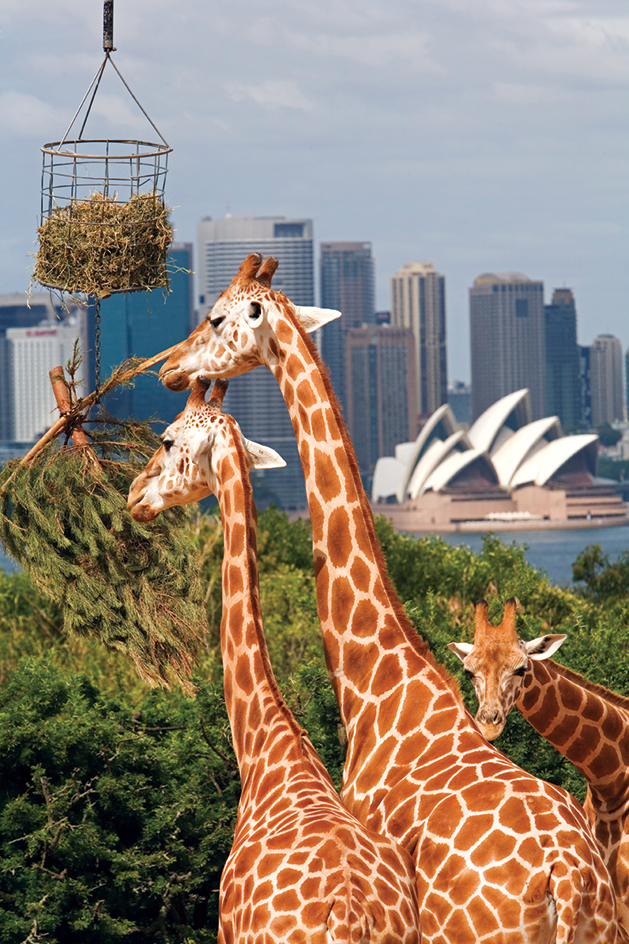
Current issues.
Some animal welfare groups criticize the treatment of animals in zoos. Some people are especially opposed to keeping large sea mammals, such as whales and dolphins, in captivity. They claim that these creatures fare poorly even under the best zoo conditions. Some animal rights activists call for all zoos to be shut down. They believe people have no right to keep animals in captivity.
Zoo officials stress the importance of zoos in conservation and science. They agree that substandard zoos should improve their treatment of animals but point out that many zoos meet high standards of care.
